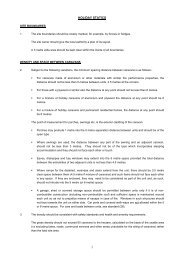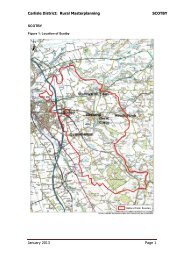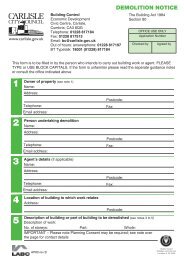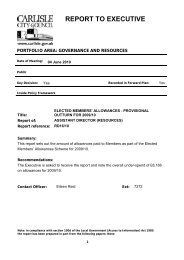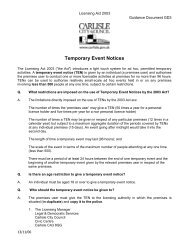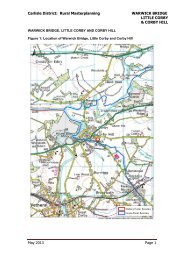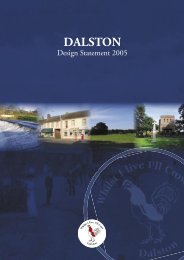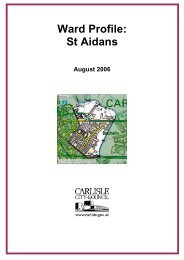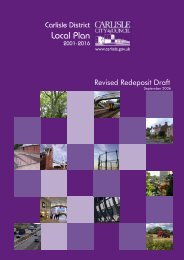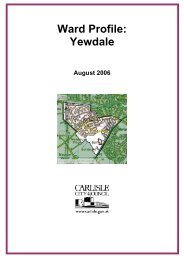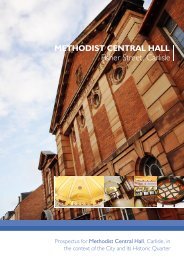Download the Management Plan - Carlisle City Council
Download the Management Plan - Carlisle City Council
Download the Management Plan - Carlisle City Council
Create successful ePaper yourself
Turn your PDF publications into a flip-book with our unique Google optimized e-Paper software.
Ragwort – this is in fairly low quantities found in grassland areas and is pulled by hand each year<br />
before seeding in July<br />
Rosebay Willowherb- found mainly but not exclusively around <strong>the</strong> Tarn edge, campsite area &<br />
roman wood. Pulled by hand each year before seeding.<br />
Canadian Pond weed – found growing in Tarn. Works carried out in past to mechanically<br />
remove have been largely unsuccessful causing spreading of weed in longer term. (dealt with in<br />
more detail under Open Water section)<br />
Blue Green Algae – found in <strong>the</strong> Tarn, see section under Open Water for details<br />
Grey Squirrels – passing regularly through <strong>the</strong> Tarn Trapping began in 2010 with assistance<br />
from Brampton Red Squirrel Group.<br />
Action<br />
Remove invasive species such as Ragwort and Rosebay Willowherb<br />
Carry out NVC survey’s to obtain baseline data for meadows<br />
Trap grey squirrels periodically depending on number of sightings<br />
Fungi<br />
The site has an impressive array of fungi and guided walks have often been held to look at <strong>the</strong>se.<br />
Two groups visited <strong>the</strong> site to study <strong>the</strong>se in 2010 and records from <strong>the</strong>se collections were added<br />
to <strong>the</strong> species records.<br />
Action<br />
Update species records<br />
Fish<br />
The site is not currently stocked with fish and species present have been added over <strong>the</strong> years.<br />
The main species are Pike and Perch with eels also present. Evidence is from Fish catches by<br />
anglers and fish remains found around <strong>the</strong> Tarn.<br />
Beetle<br />
Records have been found from <strong>the</strong> 1980’s (Tullie House) indicating that <strong>the</strong> Tarn is home to a<br />
rare (red data book 3) beetle (Macroplea appendiculata). A reed beetle whose larvae feed on <strong>the</strong><br />
roots of water plants, mainly on alternate-flowered milfoil and fennel-leaved pondweed. It is one<br />
of <strong>the</strong> few beetles that spends’ its complete life cycle underwater. It occurs in less than fifteen<br />
10km tetrads in <strong>the</strong> UK. It was re-found at Talkin Tarn by a German professor in <strong>the</strong> early<br />
2000,s but not formally recorded.(record from member of staff) Tullie House records show<br />
approx a hundred species recorded at Talkin Tarn, many of which are beetles recorded during <strong>the</strong><br />
early 1900’s.<br />
Butterflies/Moths (Lepidoptra)<br />
There are 8 species of butterfly regularly seen at Talkin Tarn, mainly around <strong>the</strong> wildflower<br />
areas. Small Copper’s tend to be seen around <strong>the</strong> Tarn edge.<br />
A moth catching evening was held at Talkin Tarn on 21 st Aug 09.<br />
Small Copper Butterfly<br />
Action<br />
Ga<strong>the</strong>r data on previous moth surveys and establish species<br />
list<br />
Dragonflies/Damselflies (Odonata)<br />
The common blue damselfly is used as <strong>the</strong> symbol of Talkin<br />
Tarn due to <strong>the</strong> sheer number of <strong>the</strong>m that emerge at <strong>the</strong> Tarn<br />
32



